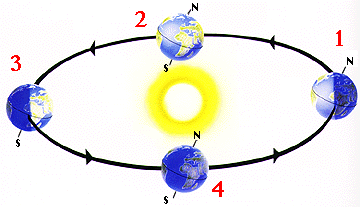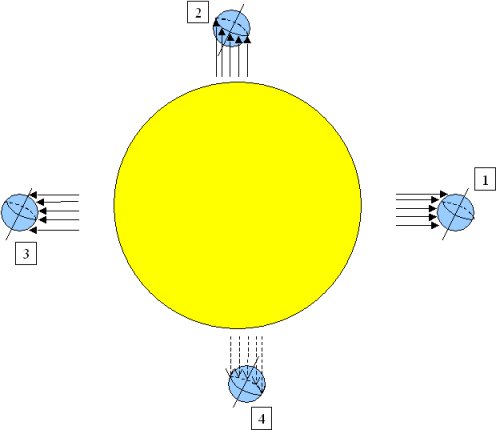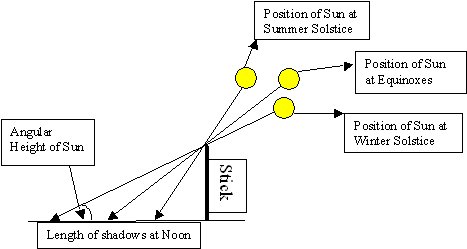Date: Tue May 18 16:35:48 1999
Posted By: Ricky J. Sethi, PhD
Area of science: Astronomy
ID: 921801910.As
Message:
Hi Denise,
Introduction
You might think that with modern technology (e.g., computers,
satellites, lasers, telescopes, etc.), this would be a relatively
trivial thing to determine today. And you'd be right. But it might
surprise you to know that the very first (accurate) known measurements
of the Earth's tilt were recorded over 2,000 years ago! And even more
fascinating is the fact that you, too, can repeat that experiment
today, using nothing more than a stick and some measuring tape!
History
Now that I've grabbed your attention (I hope), let's see how you can
become the scientist and carry out this little experiment for
yourself. But first, a little historical background. The gentleman
alluded to earlier was one Eratosthenes of Cyrene (in modern day Libya
in North Africa) who lived from about 276-194 BCE (Before Common Era).
Eratosthenes was a brilliant man who not only deduced the tilt of the
Earth but also calculated the circumference of the Earth and the
distance to the Sun (among many other things). And he wasn't the only
one, either. Abu Abdullah Al-Battani of Harran, who lived from about
868-929 CE (Common Era), also determined, with remarkable accuracy,
the obliquity of the ecliptic (in addition to the length of the
seasons, the true and mean orbit of the Sun, and many other things).
Both of these brilliant scientists managed their incredible
accomplishments without any satellites, computers, or even
calculators!
Theory
So how the heck did they do it? Well, we can employ a similar (though
understandly much less accurate :) method. First, let's examine some
of the consequences of having a tilted Earth orbiting the Sun. What
would this look like? Well, keeping in mind that the Earth is tilted
with respect to the plane of the orbit, it would look something like
Fig. 1:

Fig. 1
The above picture was taken from from this
site about the reasons for the seasons. It shows, quite nicely, that
the tilt of the Earth is really only in one direction. One of the
consequences of this is that, at different times, you will get more or
less sunlight depending on the orientation of the tilt of the Earth
with respect to the Sun (i.e., depending on what time of the year, or
season, it is). For example, in the summer, the Earth is tilted
towards the Sun so it gets more solar energy from the Sun (since
intensity = power/area). During the winter, on the other hand,
the ground receives less energy. I've made a little diagram (Fig. 2,
below) to show just the relative amount of energy the Earth receives
during various parts of it's orbit (with apologies for my lack of
artistic ability :). Just pick a spot, for example the northern
hemisphere, and see how many rays of sunshine impact that area (as
compared to the southern hemisphere, for example) during the various
parts of the orbit.

Fig. 2
What you'll find is that at position 1, with the least rays in the
northern hemisphere, it's Winter-time (Winter Solstice); at position
3, with the most rays in the northern hemisphere, it's summer-time
(Summer Solstice); and positions 2 and 4, with equal rays in both
hemispheres, are the equinoxes. So great... we know about the
solstices and the equinoxes... but what now???
Experiment
Now for the actual experiment (at last!). We can use the information
we learned in the Theory section to formulate a hypothesis and then
test out that hypothesis with our experiment. We know that the Earth
receives less energy in the winter months because of the longer angle
that the northern hemisphere's ground makes with the Sun's rays (this
is why we get less rays in the northern hemisphere during the winter
solstice, position 1 in our Fig. 2). Similarly, the northern
hemisphere's ground makes a sharper angle with the Sun's rays
during the summer months, with the sharpest angle occuring at the
summer solstice (position 3 in the diagrams above). These changing
angles of the Sun's rays at different times of the year should result
in different length shadows for the same stick measured at the same
time (e.g., noon). That is, if we put our stick in the ground at a
fixed location and measure the length of it's shadow at Noon at
various times of the year (e.g., the solstices and the equinoxes), we
should find that the length of the shadow of the stick at Noon
changes, depending on what time of the year it is. This is shown in
Fig. 3, below:

Fig. 3
So our hypothesis becomes that by measuring the different lengths of
the shadows cast by the same stick measured at the same time of day
(i.e., at Noon) but at different times of the year (i.e., the
solstices and the equinoxes), we should be able to use simple
trigonometry (Angular Height = arctan ([Length
Of Stick]/[Length of Shadow])) to determine the angular
variation of the Sun. And this angular change in the height of the
Sun, as seen from Earth, is actually a measure of the tilt of the
Earth when seen from a heliocentric point of view!
What you should find when you actually do the experiment is that the
Sun's angular height varies about 23.5o between either of
the equinoxes and the solstices. For example, the difference in
angular height of the Sun at the Winter Solstice and at the Autumn
Equinox is 23.5o (these are the first two rays in Fig. 3).
Similarly, the difference between the Summer Solstice (the 3rd ray
above) and the Vernal Equinox is also 23.5o. As a side
note, these angles are also the locations of the Tropic of Cancer and
the Tropic of Capricorn!
Epilogue...
In summary, one of the ways to determine the obliquity (tilt) of the
Earth (with respect to the plane of it's orbit), is to measure how
much the shadow cast by a stick at noon varies with the time of year.
That was a very good question and I hope this helped answer your
question somewhat. I know parts of it might be murky and slightly
confusing so you might want to elicit the help of an adult in going
over those parts that I wasn't able to explain clearly. There are
also some great sites out there on the tilt of the Earth and it's role
in the seasons. Although I didn't find any sites on actually
measuring the tilt, you might have better luck... just run a search
for some keywords (e.g., Earth, tilt, seasons, Eratosthenes, etc.) at
your favourite search engine and you should get plenty of additional
perspectives on this. But, of course, the best way to learn
anything is to actually do it... so grab a stick, make some
measurements, and get ready to wait (patience is a huge part of
what most scientists do) to confirm your hypothesis! And if you have
any questions at all, please don't hesitate to drop me a line at rickys@sethi.org.
Best of luck!
Rick.
Current Queue |
Current Queue for Astronomy |
Astronomy archives
Try the links in the MadSci Library for more information on Astronomy.
MadSci Home | Information |
Search |
Random Knowledge Generator |
MadSci Archives |
Mad Library | MAD Labs |
MAD FAQs |
Ask a ? |
Join Us! |
Help Support MadSci
MadSci Network,
webadmin@www.madsci.org
© 1995-1999. All rights reserved.



